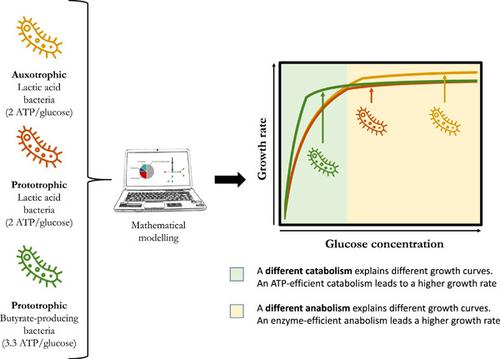当前位置:
X-MOL 学术
›
Biotechnol. Bioeng.
›
论文详情
Our official English website, www.x-mol.net, welcomes your feedback! (Note: you will need to create a separate account there.)
Resource allocation explains lactic acid production in mixed‐culture anaerobic fermentations
Biotechnology and Bioengineering ( IF 3.8 ) Pub Date : 2020-10-19 , DOI: 10.1002/bit.27605 Alberte Regueira 1 , Julius L Rombouts 2 , S Aljoscha Wahl 2 , Miguel Mauricio-Iglesias 1 , Juan M Lema 1 , Robbert Kleerebezem 2
Biotechnology and Bioengineering ( IF 3.8 ) Pub Date : 2020-10-19 , DOI: 10.1002/bit.27605 Alberte Regueira 1 , Julius L Rombouts 2 , S Aljoscha Wahl 2 , Miguel Mauricio-Iglesias 1 , Juan M Lema 1 , Robbert Kleerebezem 2
Affiliation

|
Lactate production in anaerobic carbohydrate fermentations with mixed cultures of microorganisms is generally observed only in very specific conditions: the reactor should be run discontinuously and peptides and B vitamins must be present in the culture medium as lactic acid bacteria (LAB) are typically auxotrophic for amino acids. State‐of‐the‐art anaerobic fermentation models assume that microorganisms optimise the adenosine triphosphate (ATP) yield on substrate and therefore they do not predict the less ATP efficient lactate production, which limits their application for designing lactate production in mixed‐culture fermentations. In this study, a metabolic model taking into account cellular resource allocation and limitation is proposed to predict and analyse under which conditions lactate production from glucose can be beneficial for microorganisms. The model uses a flux balances analysis approach incorporating additional constraints from the resource allocation theory and simulates glucose fermentation in a continuous reactor. This approach predicts lactate production is predicted at high dilution rates, provided that amino acids are in the culture medium. In minimal medium and lower dilution rates, mostly butyrate and no lactate is predicted. Auxotrophy for amino acids of LAB is identified to provide a competitive advantage in rich media because less resources need to be allocated for anabolic machinery and higher specific growth rates can be achieved. The Matlab™ codes required for performing the simulations presented in this study are available at https://doi.org/10.5281/zenodo.4031144.
中文翻译:

资源分配解释了混合培养厌氧发酵中乳酸的产生
厌氧碳水化合物发酵与微生物混合培养中的乳酸产生通常仅在非常特定的条件下观察到:反应器应不连续运行,培养基中必须存在肽和维生素 B,因为乳酸菌 (LAB) 通常对氨基酸是营养缺陷型的酸。最先进的厌氧发酵模型假设微生物优化了底物上的三磷酸腺苷 (ATP) 产量,因此它们不能预测 ATP 效率较低的乳酸生产,这限制了它们在混合培养发酵中设计乳酸生产的应用。在这项研究中,提出了一种考虑到细胞资源分配和限制的代谢模型,以预测和分析在哪些条件下葡萄糖产生乳酸对微生物有益。该模型使用通量平衡分析方法,结合来自资源分配理论的附加约束,并模拟连续反应器中的葡萄糖发酵。这种方法预测乳酸产量在高稀释率下预测,前提是培养基中存在氨基酸。在最低限度的培养基和较低的稀释率中,预计主要是丁酸盐,没有乳酸盐。鉴定出 LAB 氨基酸的营养缺陷型可在富培养基中提供竞争优势,因为需要分配给合成代谢机器的资源更少,并且可以实现更高的特定增长率。
更新日期:2020-10-19
中文翻译:

资源分配解释了混合培养厌氧发酵中乳酸的产生
厌氧碳水化合物发酵与微生物混合培养中的乳酸产生通常仅在非常特定的条件下观察到:反应器应不连续运行,培养基中必须存在肽和维生素 B,因为乳酸菌 (LAB) 通常对氨基酸是营养缺陷型的酸。最先进的厌氧发酵模型假设微生物优化了底物上的三磷酸腺苷 (ATP) 产量,因此它们不能预测 ATP 效率较低的乳酸生产,这限制了它们在混合培养发酵中设计乳酸生产的应用。在这项研究中,提出了一种考虑到细胞资源分配和限制的代谢模型,以预测和分析在哪些条件下葡萄糖产生乳酸对微生物有益。该模型使用通量平衡分析方法,结合来自资源分配理论的附加约束,并模拟连续反应器中的葡萄糖发酵。这种方法预测乳酸产量在高稀释率下预测,前提是培养基中存在氨基酸。在最低限度的培养基和较低的稀释率中,预计主要是丁酸盐,没有乳酸盐。鉴定出 LAB 氨基酸的营养缺陷型可在富培养基中提供竞争优势,因为需要分配给合成代谢机器的资源更少,并且可以实现更高的特定增长率。


























 京公网安备 11010802027423号
京公网安备 11010802027423号